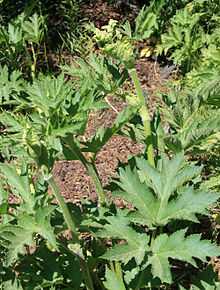Heracleum maximum
| Cow Parsnip | |
|---|---|
 | |
| Scientific classification | |
| Kingdom: | Plantae |
| (unranked): | Angiosperms |
| (unranked): | Eudicots |
| (unranked): | Asterids |
| Order: | Apiales |
| Family: | Apiaceae |
| Genus: | Heracleum |
| Species: | H. maximum |
| Binomial name | |
| Heracleum maximum Bartram | |
| Synonyms | |
|
Heracleum lanatum Michx. | |
Heracleum maximum, cow parsnip (also known as Indian celery or pushki) is the only member of the genus Heracleum native to North America. Its classification has caused some difficulty, with recent authoritative sources referring to it variously as Heracleum maximum or Heracleum lanatum , as H. linatum, or as either a subspecies, H. sphondylium subsp. montanum, or a variety, H. sphondylium var. linatum, of the common hogweed (H. sphondylium). The classification given here follows ITIS.
Distribution
Cow Parsnip is distributed throughout most of the continental United States except the Gulf Coast and a few neighboring states. It occurs from sea level to about 9000 ft,[1] and is especially prevalent in Alaska. It is listed as "Endangered" in Kentucky and "Special Concern" in Tennessee. In Canada, it is found in each province and territory, except Nunavut. It may be weedy or invasive in portions of its range.[2]
Characteristics
Cow parsnip is a tall herb, reaching to heights of over 2 metres (7 ft). The genus name Heracleum (from "Hercules") refers to the very large size of all parts of these plants.[3] Cow Parsnip has the characteristic flower umbels of the carrot family (Apiaceae), about 20 centimetres (8 in) across; these may be flat-topped or rounded, and are always white. Sometimes the outer flowers of the umbel are much larger than the inner ones. The leaves are very large, up to 40 cm (16 in) across, and divided into lobes. The stems are stout and succulent. The seeds are 8–12 mm (0.3–0.5 in) long and 5–8 mm (0.2–0.3 in) wide.[1]
The stems and leaves contain furocoumarins, a chemical responsible for the characteristic rash of erythematous vesicles (burn-like blisters) and subsequent hyperpigmentation that occurs after getting the clear sap onto one's skin. The chemical is photosensitive, with the rash occurring only after exposure to ultraviolet light. Because of this, phytophotodermatitis typically occurs after using a weed-eater to remove the plants on a sunny day.

Uses
Native American tribes had many different uses for this plant. A common use was to make poultices to be applied to bruises or sores. In addition, young stalks and leaf stems were used for food, where the outer skin was peeled off giving a sweet flavor. The dried stems were used as drinking straws for the old or infirm, and to make flutes for children.
A yellow dye can be made from the roots, and an infusion of the flowers can be rubbed on the body to repel flies and mosquitoes.[4]
The Kutenai (the Kootenai or Kootenay nation, as they refer to themselves outside of Canada) in the Northern Rockies call cow parsnip in their native language wumash (Ktunaxa: wumaǂ).[5] The Concow (Konkow or Koyom'kawi, as they refer to themselves) band of the Maidu culture in Northern California call it chou’-mē-ō (Konkow language).[6]
Similar species
The water parsnip (Sium suave), western water hemlock (Cicuta douglasii), and spotted water hemlock (Cicuta maculata) all have white flowers in large compound umbels and therefore are easily confused with cow parsnip. Water parsnip and water hemlock both have clusters of small white flowers shaped like umbrellas, and both have the same habitat near the shore line of lakes, and rivers. Water parsnip has leaves only once compound, and water hemlock has leaves which are three times compound. Water hemlock has a large swelling at the stem base. All water hemlock is highly poisonous.[7] Water parsnip is not poisonous.[8] The water hemlock has bracts at the base of each small flower cluster, not at the base of the main flower head.[9] The Water parsnip has small bracts at the base of flowers and main flower head as well.[10]
The yarrow (Achillea millefolium) also has many small white flowers in a cluster. However, the yarrow has feathery looking leaves which are pinnately separated into small narrow segments.[11]
In regions in which both cow parsnip and the phototoxic giant hogweed (H. mantegazzianum) can be found, the occurrence of cow parsnip can cause public concern due to its generally similar appearance. However, while the cow parsnip can grow up to 2 m tall, the giant hogweed lives up to its name by typically growing 2 to 5 m tall, with huge leaves to match.
External links
| Wikimedia Commons has media related to Cow Parsnip. |
- Jepson Manual species treatment
- Images from the CalPhotos archive
- Images from the Connecticut Botanical Society
- Plants for a Future report on the species
References
- ↑ 1.0 1.1 Norman F. Weeden (1996), A Sierra Nevada Flora, Wilderness Press, ISBN 0-89997-204-7
- ↑ "Heracleum maximum Bartram". PLANTS Profile. United States Department of Agriculture; Natural Resources Conservation Service. Retrieved 2008-03-30.
- ↑ Elizabeth L. Horn (1998), Sierra Nevada Wildflowers, Mountain Press, ISBN 0-87842-388-5
- ↑ University of Michigan Ethnobotany
- ↑ "FirstVoices- Ktunaxa. Plants: food plants: words.". Retrieved 2012-07-07.
- ↑ Chesnut, Victor King (1902). Plants used by the Indians of Mendocino County, California. Government Printing Office. p. 404. Retrieved 24 August 2012.
- ↑ "Cicuta maculata.". Retrieved 2008-08-03.
- ↑ "Traditional Plant Foods of Canadian Indigenous Peoples By Harriet V Kuhnlein, Nancy J.". Google books. Retrieved 2008-08-03.
- ↑ "Western Water Hemlock - Agriculture - Government of Saskatchewan". Retrieved 2008-08-03.
- ↑ "Water Parsnip - Agriculture - Government of Saskatchewan". Retrieved 2008-08-03.
- ↑ "Yarrow Achillea millefolium". Retrieved 2008-08-03.